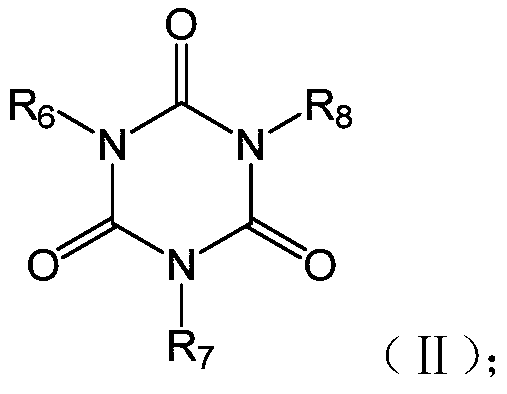Electrolyte for lithium ion battery and lithium ion battery comprising same
A lithium-ion battery and electrolyte technology, applied in the field of lithium-ion batteries, can solve problems such as oxidative decomposition, accelerate electrolyte consumption, intensify SEI film decomposition and re-film formation, and achieve the effect of reducing dissolution and improving capacity retention
- Summary
- Abstract
- Description
- Claims
- Application Information
AI Technical Summary
Problems solved by technology
Method used
Image
Examples
Embodiment 1
[0042] This embodiment provides an electrolyte solution for lithium-ion batteries, which includes, based on the total weight of the electrolyte solution: the first additive (select the compound shown in formula (III)) 1wt%, the second additive (select the compound shown in formula (IX) compound) 0.5 wt%. The lithium salt in the electrolyte is lithium hexafluorophosphate, and its concentration is 1.2 mol / L. The weight ratio of each solvent in the organic solvent used in the electrolyte is ethylene carbonate: propylene carbonate: diethyl carbonate: propyl propionate=20:20:25:35.
[0043] This embodiment also provides a secondary battery. The secondary battery is a lithium ion battery, including a positive electrode sheet, a negative electrode sheet, a diaphragm and the above-mentioned electrolyte solution for the lithium ion battery.
[0044] Wherein, the positive electrode sheet includes a positive electrode active material, a current collector, a conductive agent and a binde...
Embodiment 2
[0052] Float test
[0053] Adjust the type and content of the first additive and the second additive in Example 1 to obtain each case group, specifically refer to the following table, wherein, the types of the first additive and the second additive are shown in the aforementioned structural formulas:
[0054] Table 1. Comparison of additives in each group
[0055]
[0056] The above 16 kinds of batteries were subjected to a float charge test for 49 weeks in a 55°C incubator. The specific test method is as follows: Firstly, the battery is initialized at room temperature, and the initial capacity, thickness and internal resistance are recorded.
[0057] Tested in a constant temperature box at 55°C, (1) charge at a rate of 0.5C with constant current and constant voltage to full charge voltage, cut off current at 0.05C, and leave it for 22.8 hours; (2) discharge at a constant current of 0.05C for 60 minutes, and leave it for 10 minutes minute. The cycle time of this cycle is...
PUM
| Property | Measurement | Unit |
|---|---|---|
| Viscosity | aaaaa | aaaaa |
Abstract
Description
Claims
Application Information
 Login to View More
Login to View More - R&D
- Intellectual Property
- Life Sciences
- Materials
- Tech Scout
- Unparalleled Data Quality
- Higher Quality Content
- 60% Fewer Hallucinations
Browse by: Latest US Patents, China's latest patents, Technical Efficacy Thesaurus, Application Domain, Technology Topic, Popular Technical Reports.
© 2025 PatSnap. All rights reserved.Legal|Privacy policy|Modern Slavery Act Transparency Statement|Sitemap|About US| Contact US: help@patsnap.com



